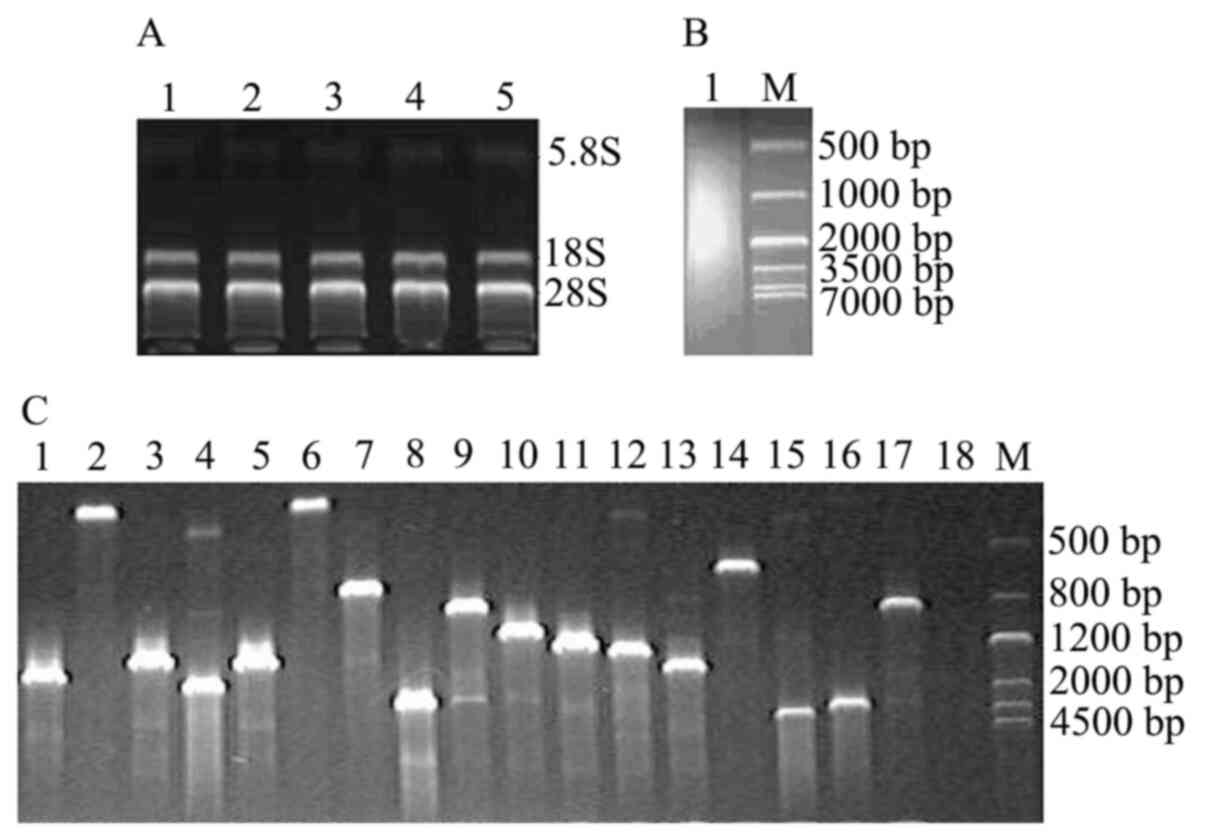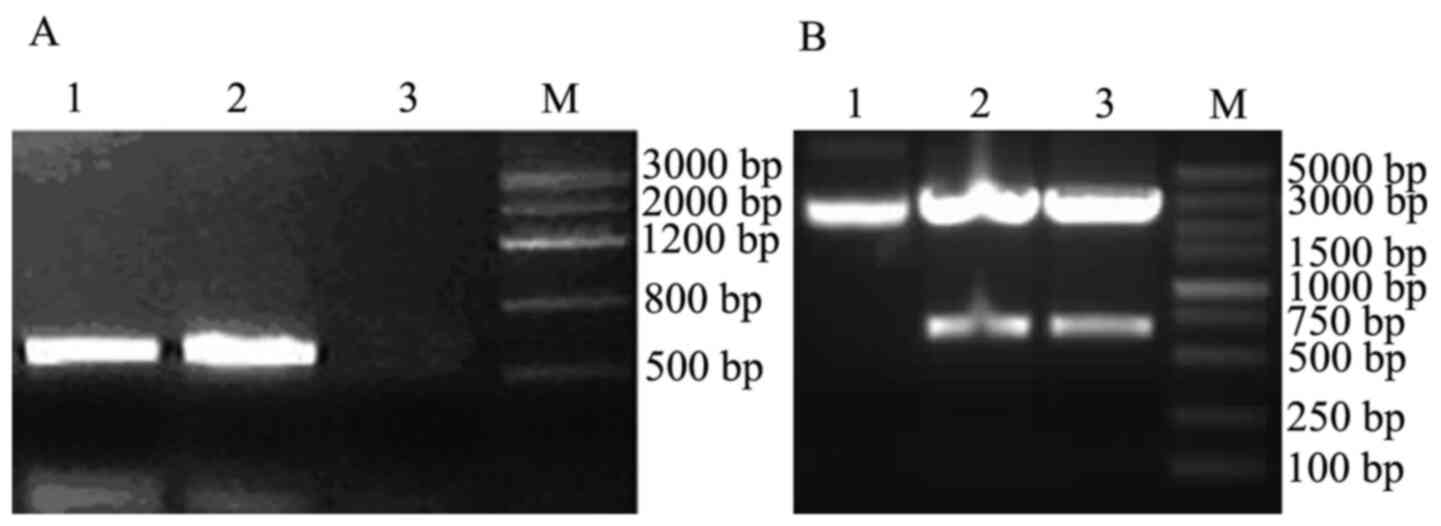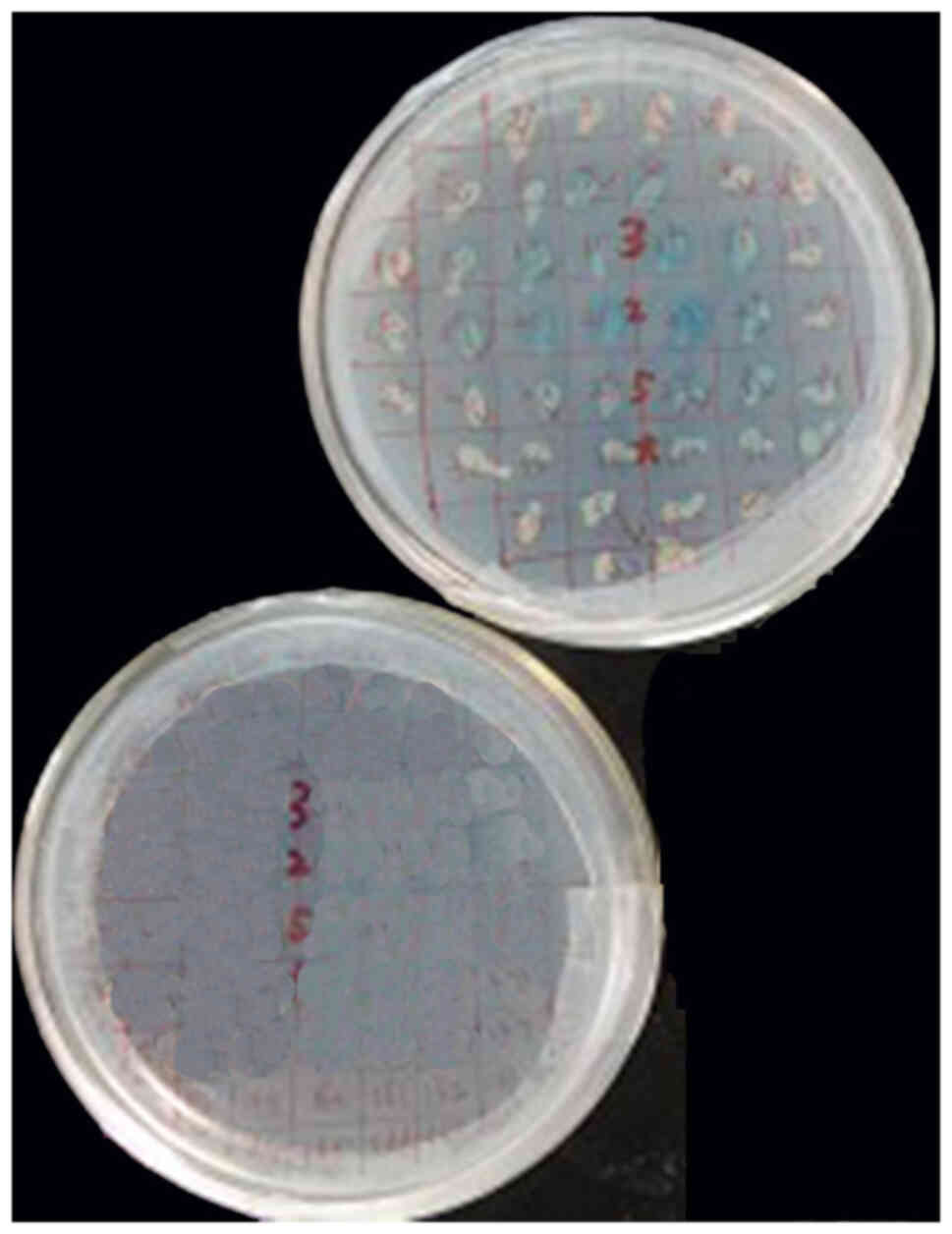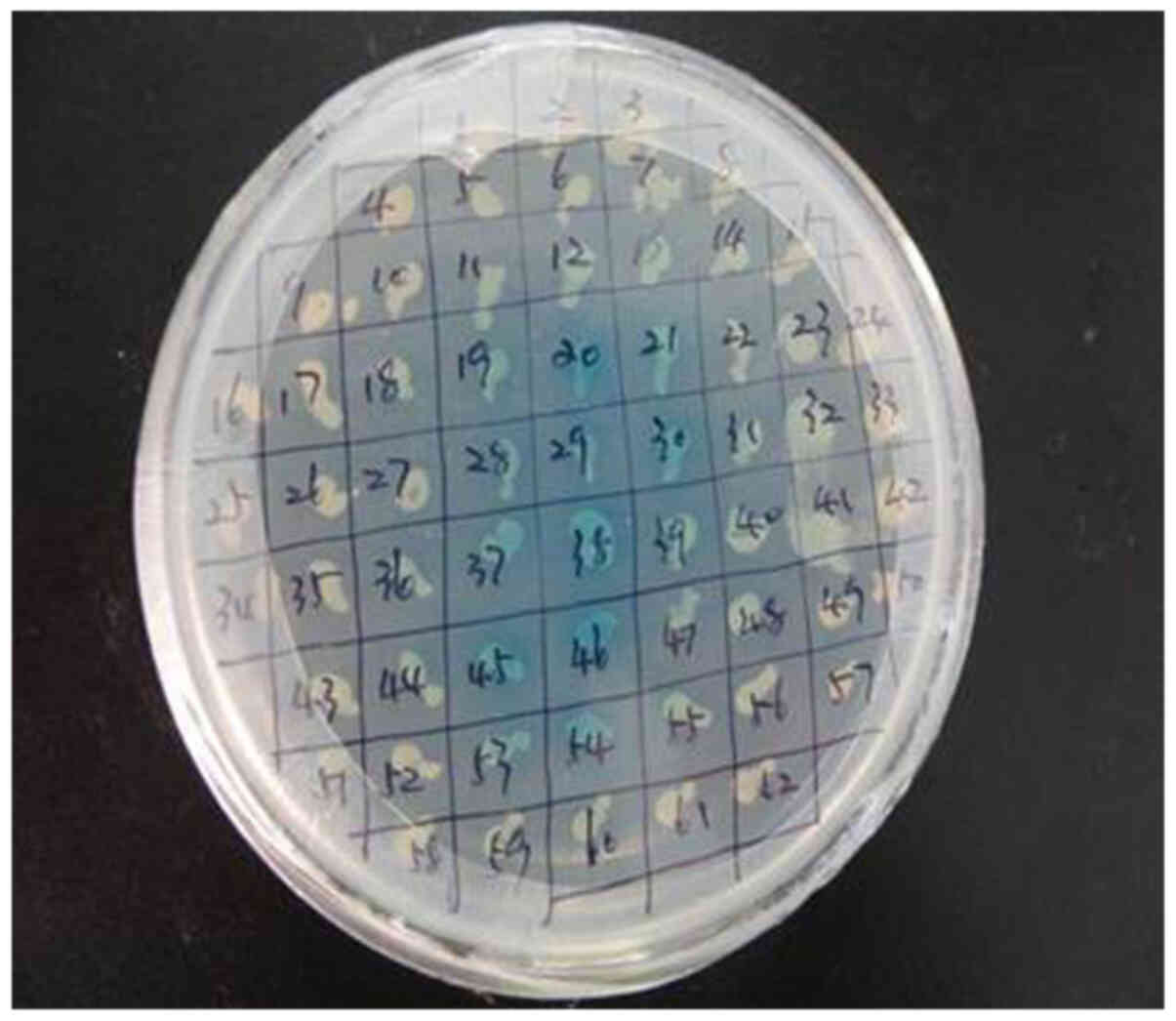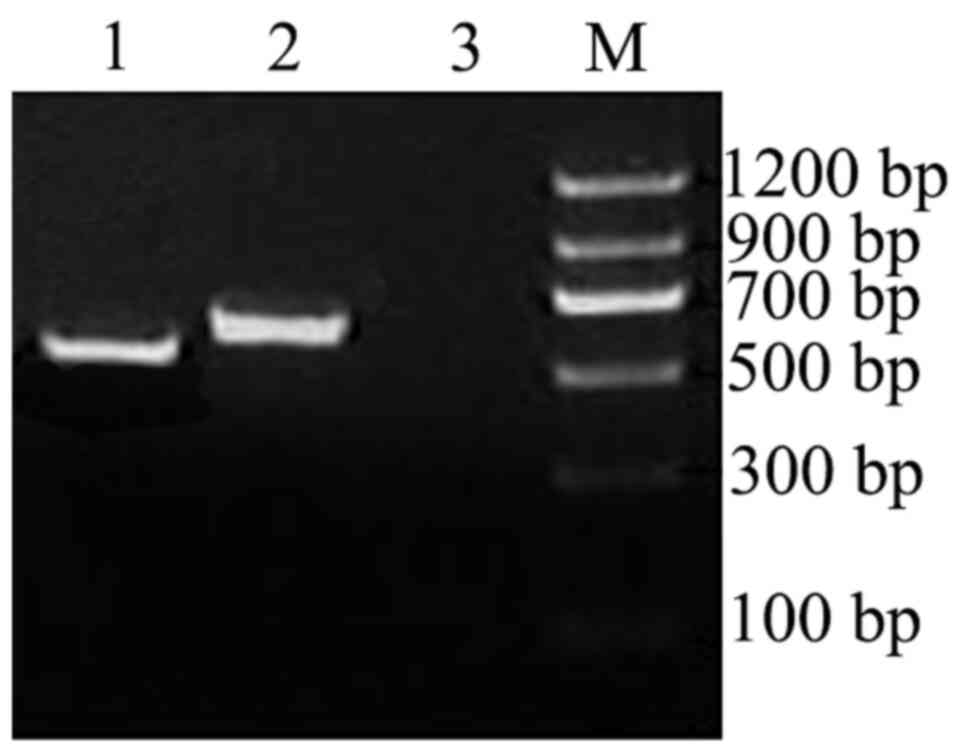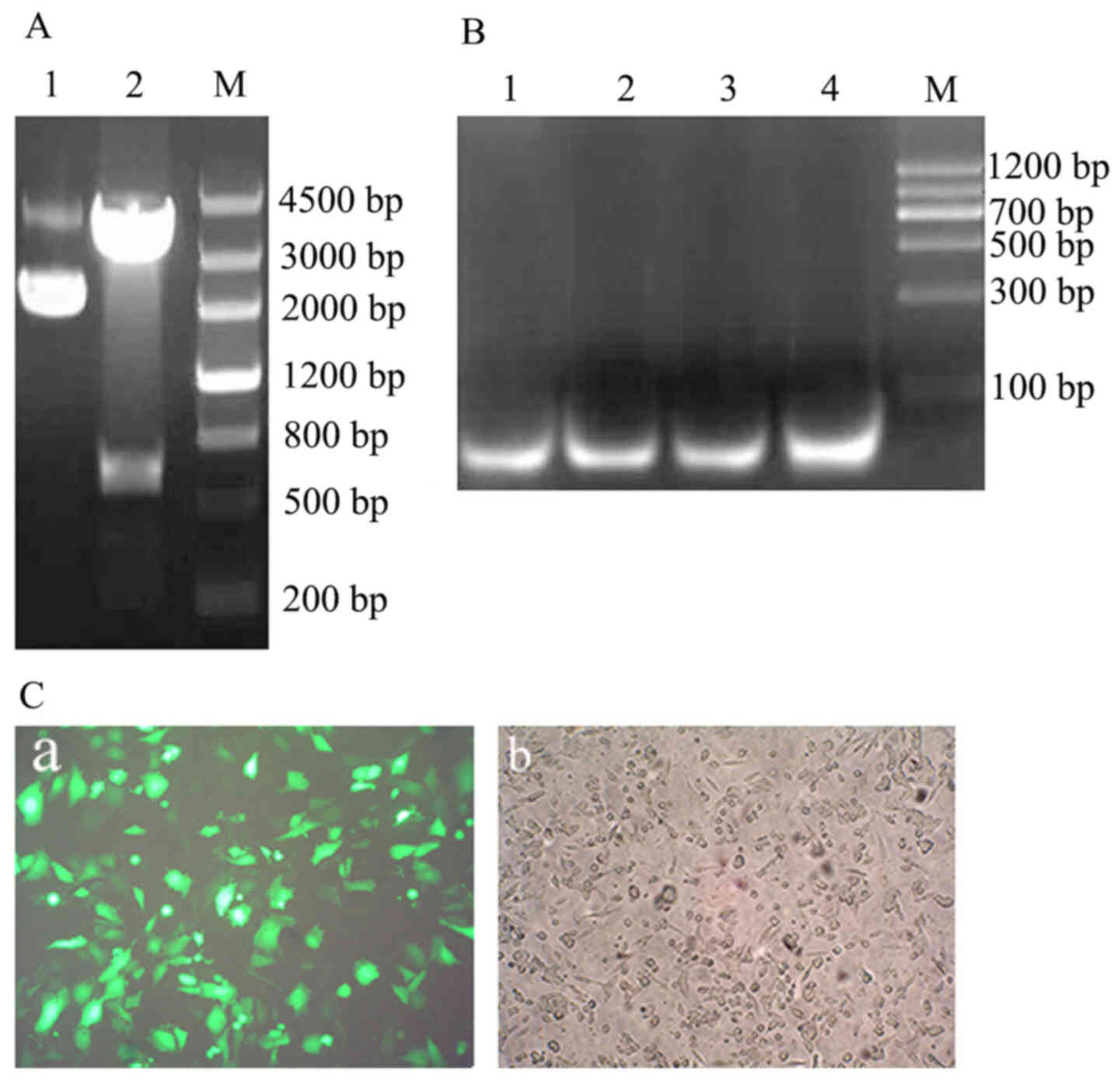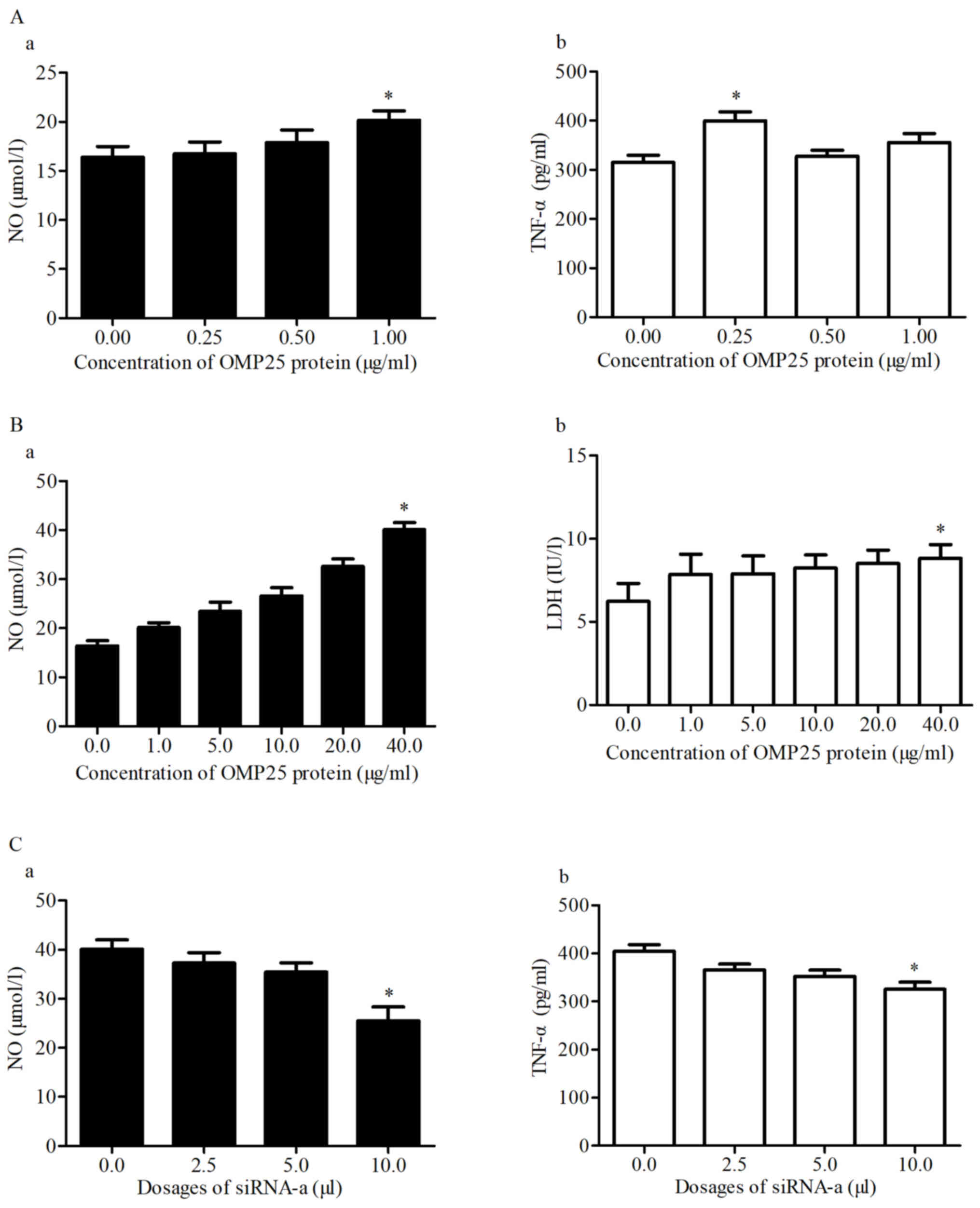Brucella melitensis outer membrane protein 25 interacts with ferritin heavy polypeptide 1 in human trophoblast cells
- Authors:
- Published online on: May 20, 2022 https://doi.org/10.3892/mmr.2022.12740
- Article Number: 224
Abstract
Introduction
Brucella melitensis (B. melitensis) is a facultatively intracellular bacterium that causes brucellosis, which is a human zoonosis that can be transmitted though infected animals or contaminated food products. Brucellosis in humans and animals can cause spontaneous abortion and diseases, such as endocarditis, arthritis, meningitis and osteomyelitis. This disease is a severe threat to human health and ruminant production, and results in economic loss worldwide (1–5).
Brucella has a small genome, but can invade the placental trophoblast cells (PTCs) of pregnant animals and subsequently result in placentitis and even spontaneous abortion (6). Brucella-infected PTCs have reportedly adapted to specific pathological changes, suggesting a unique pathogen-host relationship between B. melitensis and PTCs (7). PTCs are a link between mother and fetus and have an important role in maternal-fetal immunity (8). Dysfunction of PTCs may result in pregnancy-related diseases and Brucella interacts with PTCs and can cause infertility and spontaneous abortion (9). Thus, PTCs serve a key role in the immune system (10,11).
Bacterial outer membrane proteins (OMPs) can be easily recognized by the immune system, which produces antibodies or activates cellular immune responses (12). During infection, OMP25, a surface protein of Brucella, first establishes contact with host cells and completes the adhesion process (13). Studies have revealed that the OMP family is an important virulence factor of Brucella and that the virulence of Brucella is directly related to the uptake of iron (14–16); the pathogen efficiently uptakes iron and increases its virulence (17,18).
Ferritin heavy polypeptide 1 (FTH1) is involved in cell proliferation, immune response and iron homeostasis. Tsuji et al (19,20) reported that the upstream region of FTH1 gene contains an antioxidant response element, which responds to oxidation reaction and protects cells from oxidative damage. Oxidative reaction may lead to apoptosis (21).
Trophoblasts are target cells of Brucella and there have been a number of studies on OMP25 in cell models, including human monocyte/macrophages, microglial cells and RAW264.7 mouse macrophages (22–24). However, few studies on OMP25 in human trophoblast cells have been reported. Therefore, the present study aimed to examine this interaction in HPT-8 cells.
To improve our understanding of the interaction between OMP25 of B. melitensis 16M strain and host FTH1 in human trophoblast cell line HPT-8, the present study investigated the related changes in the biological functions of Brucella-infected HPT-8 cells. In addition, the mRNA expression levels of Toll-like receptor (TLR)4, myeloid differentiation primary response protein MyD88 (MyD88) and inflammatory factors, including nitric oxide (NO), lactate dehydrogenase (LDH) and TNF-α, in the OMP25-transfected HPT-8 cells were analyzed.
Materials and methods
Bacterial strains, plasmids and cell line
B. melitensis strain 16M strain was procured from the Chinese Center for Disease Control and Prevention (Beijing, China). Brucella was cultured in tryptic soy agar (TSA) or tryptic soy broth (both Sigma-Aldrich; Merck KGaA) without any antibiotics. Brucella was incubated in an atmosphere with 5% CO2 at 37°C for 3 days. Subsequently, the cells were observed and counted. DH5α and BL21 strains of Escherichia coli (E. coli) were procured from Promega Corporation. The two strains were grown on Luria-Bertani medium (Beijing Solarbio Science & Technology Co., Ltd.). The culture medium was supplemented with antibiotics [100 µg/ml ampicillin or kanamycin (Invitrogen; Thermo Fisher Scientific, Inc.)] when necessary. Purification of OMP25 recombinant protein was performed as previously reported (24). pGBKT7, a plasmid, was procured from Promega Corporation. pMD18-T simple vector, another plasmid, was procured from Takara Bio, Inc. DNA ladder was procured from Takara Bio, Inc. The human trophoblast HPT-8 cell line was procured from Cell Resource Center (http://m.cellresource.cn/content.aspx) and was cultured in Dulbecco's modified Eagle's medium (DMEM, Gibco; Thermo Fisher Scientific, Inc.) supplemented with 10% fetal bovine serum (FBS, Gibco; Thermo Fisher Scientific, Inc.) at 37°C in an atmosphere with 5% CO2 (vol/vol).
Construction of a cDNA library of HPT-8 cells infected with B. melitensis 16M strain
A cDNA library of HPT-8 cells infected with B. melitensis 16M strain was constructed as previously described (25). Briefly, the number of HPT-8 cells was determined using flow cytometry. Viable B. melitensis 16M strain was obtained by plating serially diluted colony-forming units on TSA after a 4 day-incubation at 37°C in an atmosphere with 5% CO2. The HPT-8 cells were infected with the 16M strain at a dilution of 100:1 for 4 h at 37°C. The infected cells were incubated at 37°C in an atmosphere with 5% CO2.
To validate infection efficiency, genomic DNA was separately prepared using a number of the infected cells (1×105/ml) using a DNeasy® Blood & Tissue kit (Qiagen GmbH), according to the manufacturer's protocols. OMP25-F and OMP25-R primers (Table I) were designed for the amplification of the OMP25 gene.
To construct a cDNA library of HPT-8 cells, total RNA was separately prepared from the infected cells using TRIzol® (Thermo Fisher Scientific, Inc.) and Ultrapure RNA kit (CoWin Biosciences; cat. no. CW0597S), according to the manufacturer's protocols. HPT-8 cDNA library construction was performed according to Make Your Own ‘Mate & Plate’ Library System Protocol (Clontech Laboratories, Inc.) as previously described (26). The inserts of cDNA library were detected by long-distance PCR (LD-PCR) as previously described (26) with some modifications. The LD-PCR reaction conditions were as follows: 1 min at 95°C, followed by 40 cycles at 95°C for 15 sec, 68°C for 3 min.
Construction of the pGBKT7-OMP25 bait system
The open reading frame of OMP25 in the genome of B. melitensis 16M was amplified using OMP25-F and OMP25-R primers (Table I). The total PCR reaction volume was 15 µl, containing ddH2O 13.9 µl, Up-primer (25 µM) 0.4 µl, Down-primer (25 µM) 0.4 µl, dNTP (2.5 mmol) 0.8 µl, 10× PCR Buffer 2.0 µl, Templet (genome of B. melitensis 16M) 2.0 µl, Taq DNA Polymerase (5 U/µl) 0.5 µl. The PCR reaction conditions were as follows: 5 min at 95°C, followed by 30 cycles at 94°C for 30 sec, 55°C for 45 sec and 72°C for 1 min, and 10 min at 72°C. The PCR product was cloned into pGBKT7 vector via EcoR I/Xho I sites, and to generate a recombinant plasmid: pGBKT7-OMP25. The recombinant pGBKT7-OMP25 plasmid was transformed into the Y2HGold yeast strain.
Negative and positive controls of yeast two-hybrid system
Yeast two-hybrid test was performed, as previously described (27). Competent Y187 cells that were transformed with pGADT7-T from the Matchmaker™ Gold Yeast Two-Hybrid System (Clontech Laboratories, Inc.) was used as a control for the prey system and pGBKT7-53 and pGBKT7-Lam-transformed yeast Y187 cells were used as a positive and negative controls, respectively. Then, pre-two-hybrid experiments were then performed to test the positive and negative control systems.
Interactive screening of Y2HGold (pGBKT7-OMP25) and Y187 (pGADT7-cDNA) yeast strains
The pGBKT7-OMP25-containing yeast Y2HGold was inoculated into 50 ml SD/-Trp/Kan (Clontech Laboratories, Inc.) liquid medium (50 µg/ml) and cultured for 20 h at 30°C with shaking at 10.48 × g. The bacterial density was adjusted to >109/ml by a centrifugation at 1,000 × g at 30°C for 10 min. Yeast Y187 cells with a density of >2×107/ml stored at −80°C were thawed and yeast two-hybrid assays were performed using Matchmaker™ Gold Yeast Two-Hybrid System (Clontech Laboratories, Inc.). The resuspended yeast culture was spread onto 150 mm SD/-Ade/-His/-Leu/-Trp/X-α-Gal (QDO/X) plates (Clontech Laboratories, Inc.) that were inverted and incubated at 30°C for 72 h. Afterwards, the recombinant plasmids were extracted from the positive colonies that were identified by SD/-Ade/-His/-Leu/-Trp screening, PCR amplification and sequencing. The PCR reaction volume and conditions were described above.
Validation of the yeast two-hybrid results by co-immunoprecipitation (Co-IP)
The pGBKT7-OMP25 and positive plasmids identified by pGADT7-cDNA library screening were transcribed and translated using a TNT T7 polymerase-coupled reticulocyte lysate system (Promega Corporation). Briefly, the total reaction volume of TNT T7 transcription and translation was 25 µl, containing TNT Rabbit Reticulyte Lysate 12.5 µl, TNT Reaction Buffer 1 µl, Amino Acid Mixture Minus Leucine (1 mM) 0.5 µl, Amino Acid Mixture Minus Methionine (1 mM) 0.5 µl, Recombinant RNasin Ribonuclease Inhibitor (40 U/µl) 0.5 µl, DNA template 1.0 µl, Transcend tRNA 0.5 µl, Nuclease-Free Water 7.0 µl, TNT RNA Polymerase 0.5 µl. In vitro transcribed and translated bait and prey proteins (10 µl) were incubated at room temperature for 1 h. Then, 10 µl c-Myc monoclonal antibody (cat. no. MA1-980; Invitrogen; Thermo Fisher Scientific, Inc.) was added to the protein mixture and the mixture was incubated at room temperature for another 1 h. Subsequently, the above samples were added to a centrifuge tube containing 3 µl Protein A bead (Matchmaker™ Co-IP kit, cat. no. 630449, Clontech Laboratories, Inc.) and incubated at room temperature for 1 h. Then 500 µl Buffer 1 was added and centrifuged at 350 × g for 30 sec at room temperature. The supernatant was discarded, 600 µl Buffer 2 added and centrifuged at 350 × g for 30 sec at room temperature and the supernatant discarded. The proteins were electrophoresed via SDS-PAGE on 12% gels and electrotransferred to a nitro-cellulose (NC) membrane using a Mini Trans-Blot Cell (Bio-Rad Laboratories, Inc.) at 200 mA for 1 h. The NC membrane was incubated in blocking solution [5% nonfat milk in Tris-buffered saline 0.05% Tween-20 (TBST)] for 1 h at room temperature. Then the membrane was incubated in binding buffer (6 µl Streptavidin-AP in 15 ml TBST) at room temperature for 1 h. After three washes with TBST, the membrane was stained with Western Blue Stabilized Substrate (Promega Corporation) at room temperature for 2–6 h. The signal was detected and densitometry performed by a Micro-Chemi instrument (GelView 6000Plus, Guangzhou Biolight Biotechnology Co., Ltd.).
Reverse transcription-quantitative (RT-q) PCR
The total RNA was separately prepared from the infected cells using TRIzol® (Thermo Fisher Scientific, Inc.) and Ultrapure RNA kit (CoWin Biosciences; cat. no. CW0597S), according to the manufacturer's protocols. cDNA was synthesized from the total RNA of the infected cells (1×105) using reverse transcription kit (cat. no. 639505; Takara Biotechnology Co., Ltd.) at 42°C for 50 min and at 85°C for 5 min, and was then used as a PCR template for amplification of FTH1 and construction of pGM-T-A/B/C/D plasmids. The plasmids were extracted from the positive clones that were identified using PCR and considered a reference standard after determining the concentration of plasmids. Furthermore, the pGM-T-FTH1 plasmid was identified using EcoR I/Xho I digestion. Genes were amplified as templates with pGM-T-FTH1 plasmid, 16M, GAPDH and HPT-8 cDNA with primers (Table I) designed for FTH1, 16S rRNA and reference gene GAPDH. RT-qPCR was performed according to Roche LightCycler® 480 (Roche Diagnostics, Switzerland) protocol; standard curves were generated based on the standard templates. SYBR Green I Master was used as fluorophore (Roche Diagnostics). The total RT-qPCR reaction volume was 10 µl, containing ddH2O 3.6 µl, up-primer (10 µM) 0.2 µl, down-primer (10 µM) 0.2 µl, template 1.0 µl, SYBR Green I Master 5.0 µl. The thermocycling conditions were as follows: Preincubation for 5 min at 95°C, and then 40 cycles of amplification (95°C for 30 sec, 60°C for 30 sec and 72°C for 30 sec). The relative transcriptional levels were determined using the 2−∆∆Cq method (28). All assays were performed in triplicate and repeated at least three times.
Construction of pSIREN-siRNA vector targeting FTH1 gene
The human FTH1 gene (NCBI Reference Sequence: NM_002032) was submitted to Ambion (Thermo Fisher Scientific, Inc.); three pairs of positive small interfering (si)RNA fragments were identified for the FTH1 gene and a pair of siRNA fragments containing a different gene was considered the negative control (Table II). siRNA fragments were synthesized by Sangon Biotech Co., Ltd. pSIREN-siRNA expression vector with green fluorescent protein was constructed according to the RNAi-Ready pSIREN-RetroQ ZsGreen Vector kit (Clontech Laboratories, Inc.) protocol. The diluted siRNA fragment (antisense strand) concentration was 100 µmol/l and the PCR conditions were as follows: 95°C for 30 sec, 72°C for 2 min, 37°C for 2 min and 25°C for 2 min. Synthetic double strands were diluted to 0.5 µmol/l and 5 µl synthetic double strands were electrophoresed in 1% agarose gel containing ethidium bromide; the DNA fragments were ligated using RNAi-Ready pSIREN-RetroQ ZsGreen Vector at 16°C overnight. Subsequently, the ligated product was transformed into competent E. coli DH5α cells for 16–18 h and sequenced by Sangon Biotech Co., Ltd., to identify the positive plasmids, and digested using Mlu I and named pSIREN-A/B/C/D. The plasmids were prepared using Endotoxin-Free Plasmid Highpure kit (Tiangen Biotech Co., Ltd.), according to the manufacturer's protocols.
Detection of pSIREN-siRNA interference effect
pSIREN-A/B/C/D plasmids were transfected into HTP-8 cells using a Lipofectamine® 2000 Transfection Reagent kit (cat. no. 11668030; Invitrogen Co., Ltd.), and pSIREN-D was used as the negative control. The transfected HPT-8 cells were cultured in an atmosphere with 5% CO2 at 37°C for 48 h and HPT-8 containing green fluorescent protein were observed under a LSM510 confocal laser scanning microscope (Zeiss GmbH). Total RNA was extracted from the transfected HTP-8 cells using Ultrapure RNA kit (CoWin Biosciences, cat. no. CW0597S), according to the manufacturer's protocols. cDNA was synthesized using a first-strand cDNA synthesis kit (CoWin Biosciences, cat. no. CW0741), according to the manufacturer's protocols. The mRNA expression of FTH1 gene was measured using RT-PCR as described above. The target gene detection value and the reference gene detection value were regarded as a correction value in evaluating the effect of each interfering plasmid and were statistically analyzed before and after transfection. The FTH1 gene corresponding value/GAPDH detection value was used as a correction value and interference efficiency was calculated as follows: Interference efficiency (%)=(RNAi negative control group-RNAi test group)/RNAi negative control group ×100% (29).
Determination of OMP25 concentration by Bradford protein assay
The determination of OMP25 concentration was performed using a protein assay kit (Shanghai Yeasen Biotechnology Co., Ltd.).
Expression levels of NO, TNF-α and LDH in HPT-8 cells transfected with OMP25
The expression levels of NO, TNF-α and LDH were measured as previously described (30). HPT-8 cells were used to evaluated the effects of NO, TNF-α and LDH activity. Briefly, 1×106 cells/well were cultured in a 24-well plate for 24 h at 37°C and transfected with OMP25 at low doses (0.25, 0.5 and 1 µg/ml) or high doses (1, 5, 10, 20 and 40 µg/ml). A group without OMP25 was used as a control. Subsequently, 24 or 48 h post-transfection, the supernatant was centrifuged at 16,000 × g at room temperature for 15 min and collected, NO and TNF-α expression levels were determined using a ELISA kit (NO, cat. no. KGE001; TNF-α, cat. no. DTA00D; R&D Systems, Inc.) and LDH expression level was determined using LDH assay kit (cat. no. ab102526; Abcam, Inc.), according to the manufacturer's protocols.
Expression levels of NO and TNF-α following pEGFP-OMP25 plasmid and siRNA-c co-transfection
Monolayers of HPT-8 cells at a density of 1×106 cells/well were cultured in a 6-well plate until the cells achieved ~60% confluence. pEGFP-OMP25 (3 µg) and siRNA-c (0, 2.5, 5, or 10 µl) were co-transfected into HPT-8 cells using Lipofectamine® 2000 reagent (Invitrogen; Thermo Fisher Scientific, Inc.) according to the manufacturer's protocol. At 48 h post-transfection, the supernatant was centrifuged at 16,000 × g at room temperature for 15 min and collected, and the expression levels of NO and TNF-α were measured as described above.
RT-qPCR for detection of TLR4 and MyD88 mRNA levels
To determine the mRNA levels of TLR4 and MyD88, the genes of TLR4 and MyD88 were cloned into pMD18-T simple vector. The standard curves of RT-qPCR were constructed using the primers TLR4-S, TLR4-A, MyD88-S and MyD88-A (Table I). RT-qPCR was performed as described above to measure TLR4 and MyD88 mRNA levels and the results were normalized against the standard curves.
Statistical analysis
The statistical differences between the groups were analyzed using one-way analysis of variance (ANOVA) followed by Tukey's post hoc test. The expression levels of NO, TNF-α and LDH are presented as the mean ± standard deviation. The differences between groups were analyzed using ANOVA in SPSS 17.0 software (SPSS, Inc.). P<0.05 was considered to indicate a statistically significant difference. The experiments were repeated three times.
Results
Detection of infected HPT-8 cells
Three bands corresponding to 28S, 18S and 5.8S rRNA in the total RNA extracts were observed (Fig. 1A). The A260/280 value was 1.90 (20 min post-infection), 2.02 (1 h post-infection), 1.92 (2 h post-infection), 1.85 (3 h post-infection) and 2.04 (4 h post-infection), indicating the high purity of the total RNA. The library capacity of the cDNA was 1.43×106 transformants; thereby reaching the construction requirements. The cDNA library was also uncontaminated. The size of the cDNA insert fragments were mainly in the range of 0.2–5 kb and with the majority near the 1–2 kb region (Fig. 1B and C).
Yeast two-hybrid assay
DNA fragments of 640 bp size obtained using PCR and restriction enzyme digestion indicated that the target was the plasmid pGBKT7-OMP25. Y2HGold containing pGBKT7-OMP25 had no self-activation or toxicity for cells (Fig. 2A and B).
Control assay
Blue colonies (2–3 mm) on the SD/-Ade/-His/-Leu/-Trp/X-α-Gal plates with Y187 (pGADT7-T) that matched Y2HGold (pGBKT7-53) as positive control were observed. No colonies were grown on the SD/-Ade/-His/-Leu/-Trp/X-α-Gal plates with Y187 (pGADT7-T) that matched Y2HGold (pGBKT7-lam) as negative control (Fig. 3).
Interaction between prey protein and OMP25 bait protein
Colonies of 2–3 mm on SD/-Ade/-His/-Leu/-Trp plates with Y2HGold (pGBKT7-OMP25) matched Y187 (pGADT7-library) and these colonies switched to SD/-Ade/-His/-Leu/-Trp/X-α-Gal changed into blue colonies and were considered the positive colonies (Fig. 4). The OMP25 bait protein gene trap sequence of the prey protein gene was analyzed and the results indicated that the pGBKT7-OMP25 bait plasmid eventually yielded seven positive AD plasmids. Blast analysis results are shown in Table III.
Verification of the interaction between prey protein and OMP25 by Co-IP
OMP25 carrying c-myc tag and FTH1 carrying HA tag, were amplified with templates as pGBKT7-OMP25 and pGADT7-prey (FTH1 gene) using Advantage 2 PCR kit protocol (Fig. 5). The Co-IP results indicated that OMP25 interacted with FTH1.
Bio-function of the interaction between FTH1 and OMP25 during brucellosis
The obtained FTH1 gene ligated into pGM-T vector generated a positive plasmid: pGM-FTH1; which was identified using EcoR I/Xho I digestion and target fragment indicated a 550 bp band (Fig. 6A).
The results of the green fluorescent protein expression vector pSIREN-siRNA transfection indicated that a 69 bp positive fragment was inserted into Linearized pSIREN Vector and was sequenced (Fig. 6B); the sequencing results indicated that four small fragments of DNA sequences were identical with sequences in the original sequence.
The RT-qPCR detection results of Brucella survival ability in the transfected cells indicated that the relative expression of 16S rRNA decreased by ~84% in HPT-8 cells containing interference plasmid vs. empty HPT-8 cells infected with Brucella; the viability of brucella was decreased in the host cells transfected with FTH1 interference fragment.
HPT-8 cells were transfected and subsequently observed under a LSM 510 Laser scanning confocal microscope 48 h post-transfection. The results indicated green fluorescence protein expression in HPT-8 cells and a ~100% plasmid transfection efficiency was achieved (Fig. 5C-a and C-b).
The interference effect of four RNAi plasmids, namely pSIREN-A, pSIREN-B, pSIREN-C and pSIREN-D on the FTH1 gene were detected, respectively. pSIREN-A, pSIREN-B and pSIREN-C interference plasmids exerted interference effects and an interference efficiency of ≤98% was achieved for pSIREN-C (Table IV).
NO, TNF-α and LDH activity in HPT-8 cells treated with OMP25 and siRNA-a
Low doses of OMP25 affected HPT-8 cells after 24 h and the levels of NO and TNF-α were positively associated with the concentration of OMP25 (Fig. 7A-a and -b). High doses of OMP25 affected HPT-8 cells after 24 h and the levels of NO and LDH were increased with the concentration of OMP25 (Fig. 7B-a and -b). Different doses of siRNA-a were transfected into HPT-8 cells and the levels of NO and LDH were decreased with the concentration of siRNA-a (Fig. 7C-a and C-b).
TLR4 and MyD88 mRNAs levels in HPT-8 cells treated with OMP25 protein and siRNA-c
Low doses of OMP25 affected HPT-8 cells and the relative expression levels of TLR4 and MyD88 were associated with the concentration of OMP25 (Fig. 8A). No significant differences observed for TLR4 (Fig. 8A).
siRNA-c and pGEFP-OMP25 were co-transfected into HPT-8 cells and the relative expression levels of TLR4 were decreased with the increase of the concentration of siRNA-c (Fig. 8B).
Discussion
B. melitensis can efficiently invade trophoblast cells in mammals and rapidly multiply within the placenta, which can result in spontaneous abortion and placentitis (24,25). Trophoblast cells are therefore the primary target cells of B. melitensis in the infected host; however, the infection of trophoblast cells remain poorly understood. Spontaneous abortion in pregnant women resulting from brucellosis may indicate that if Brucella can reach the placenta and enter trophoblasts (27,30), they may also become an important cellular niche. In vitro studies regarding intracellular trafficking are few. The present study successfully obtained a cDNA library from HPT-8 cell lines infected with B. melitensis strain 16M and demonstrated that the protein OMP25 directly interacts with eukaryotic proteins such as FTH1, suggesting that OMP25 is a functional protein involved in the alteration of host cell processes. The interactions between B. melitensis protein and host proteins in vivo further indicated that Brucella protein OMP25 serves an important role in the modulation of host cells via protein-protein or protein-DNA interactions.
B. melitensis OMP25 is a virulence protein involved in intracellular replication. LDH, an intracellular enzyme, is released into the extracellular matrix when cells are damaged or undergo death; this results in an increase in LDH activity in cell supernatants. In addition, LDH is considered an index for cell injury (31). OMP25 at concentrations >5 µg/ml resulted in increased amounts of LDH in HPT-8 cells.
TLR is expressed on the surface of epithelial cells and is important to bacterial infection. The present study found that TLR4 mRNA was lowly expressed in the HPT-8 cells, whereas a low concentration of OMP25 upregulated TLR4 and inflammatory signaling molecules, including TNF-α and NO, in the HPT-8 cells. The activation of TLR4, MyD88, TNF-α and NO resulted in the activation of the nuclear transcription factor NF-κB, which may serve a key regulatory role in a variety of inflammatory responses in host cells.
In a previous study (32), we found that OMP25 serves an important role in the activation of the MAPK signaling pathway in HPT-8 cells infected with Brucella. 2308ΔOmp25 mutant strain could not activate p38 phosphorylation protein, ERK and JNK branches in HPT-8 cells. However, in the present study, it was found that OMP25 interacts with FTH1 in HPT-8 cells. The present study provided a theoretical basis regarding the new functions of OMP25.
The present study focused on the interaction between OMP25 and key molecules of trophoblast cells. Further studies, including on cell and animal experiments, are required to confirm whether OMP25 can help in the infection of trophoblast cells. The present study did not prove that OMP25 can help trophoblast infection and this is one of its limitations.
In conclusion, the results of the present study indicated that OMP25 interacts with FTH1. The mRNA expression levels of TLR4, MyD88 and inflammatory factors, including NO, LDH and TNF-α significantly increased after the interaction of OMP25 and FTH1 in the HPT-8 cells. OMP25-FTH1 interaction may contribute to the exacerbation of the intracellular replication of Brucella and the likelihood of a subsequent abortion or stillbirth of the infected fetus. Further research is required to elucidate the mechanisms underlying the molecular interactions of OMP25 with the host, such that other Brucella effector proteins and host cell targets can be identified to further elucidate and define the molecular mechanisms of brucellosis. Furthermore, the present study clarified the pathogenic mechanism of brucellosis and may yield novel insights for the development of therapeutic options.
Acknowledgements
Not applicable.
Funding
The present study was supported by grants from the National Natural Science Foundation of China (grant no. 31860691), the Key Scientific Research Project of Colleges and Universities in Henan Province (grant no. 21A230015), the National Innovation Training Program for College Students of China (grant no. 202010483007), the Foundation of the Technology Department of Henan Province (grant no. 212102310746), the International Science and Technology Cooperation Promotion Plan (grant no. GJHZ201709), the Training Program for Excellent Young Teachers Colleges and Universities of Corps (grant no. CZ027202), the Youth Science and technology innovation leading talent program of Corps (grant no. 2017CB002) and the Science and Technology Research and Development Program (grant no. RCZX201403).
Availability of data and materials
The datasets used and/or analyzed during the current study are available from the corresponding author on reasonable request.
Authors' contributions
HZ, ZL, CC, CW and JL contributed to the conception and design of the experiment. HZ, XW, ZL, JZ, YZ and YW performed all experiments and verified the analytical data. JZ, YZ and YW contributed to the statistical analysis and helped interpret the results. HZ supervised the experiments in discussion with ZL. JZ, YZ and YW wrote the manuscript. JL and HZ confirm the authenticity of all the raw data. All authors discussed the final results and all authors read and approved the final manuscript.
Ethics approval and consent to participate
Not applicable.
Patient consent for publication
Not applicable.
Competing interests
The authors declare that they have no competing interests.
References
|
Purwar S, Metgud SC, Karadesai SG, Nagamoti MB, Darshan A and Tiwari S: Triad of infective endocarditis, splenic abscess, and septicemia caused by Brucella melitensis. J Lab Physicians. 9:340–342. 2017. View Article : Google Scholar : PubMed/NCBI | |
|
Asmare K: Neospora caninum versus Brucella spp. exposure among dairy cattle in Ethiopia: A case control study. Trop Anim Health Prod. 46:961–966. 2014. View Article : Google Scholar : PubMed/NCBI | |
|
Cash-Goldwasser S, Maze MJ, Rubach MP, Biggs HM, Stoddard RA, Sharples KJ, Halliday JEB, Cleaveland S, Shand MC, Mmbaga BT, et al: Risk factors for human brucellosis in Northern Tanzania. Am J Trop Med Hyg. 98:598–606. 2018. View Article : Google Scholar : PubMed/NCBI | |
|
Bayasgalan C, Chultemdorj T, Roth F, Zinsstag J, Hattendorf J, Badmaa B, Argamjav B and Schelling E: Risk factors of brucellosis seropositivity in bactrian camels of Mongolia. BMC Vet Res. 14:3422018. View Article : Google Scholar : PubMed/NCBI | |
|
El-Sayed A and Awad W: Brucellosis: Evolution and expected comeback. Int J Vet Sci Med. 6 (Suppl 1):S31–S35. 2018. View Article : Google Scholar : PubMed/NCBI | |
|
Meador VP and Deyoe BL: Intracellular localization of Brucella abortus in bovine placenta. Vet Pathol. 26:513–515. 1989. View Article : Google Scholar : PubMed/NCBI | |
|
Zhang J, Li M, Li Z, Shi J, Zhang Y, Deng X, Liu L, Wang Z, Qi Y and Zhang H: Deletion of the type IV secretion system effector VceA promotes autophagy and inhibits apoptosis in Brucella-Infected human trophoblast cells. Curr Microbiol. 76:510–519. 2019. View Article : Google Scholar : PubMed/NCBI | |
|
von Bargen K, Gorvel JP and Salcedo SP: Internal affairs: Investigating the Brucella intracellular lifestyle. FEMS Microbiol Rev. 36:533–562. 2012. View Article : Google Scholar : PubMed/NCBI | |
|
Anderson TD and Cheville NF: Ultrastructural morphometric analysis of Brucella abortus-infected trophoblasts in experimental placentitis. Bacterial replication occurs in rough endoplasmic reticulum. Am J Pathol. 124:226–237. 1986.PubMed/NCBI | |
|
Sidhu-Muñoz RS, Sancho P and Vizcaíno N: Evaluation of human trophoblasts and ovine testis cell lines for the study of the intracellular pathogen Brucella ovis. FEMS Microbiol Lett; 365. 2018, PubMed/NCBI | |
|
Watanabe K, Tachibana M, Tanaka S, Furuoka H, Horiuchi M, Suzuki H and Watarai M: Heat shock cognate protein 70 contributes to Brucella invasion into trophoblast giant cells that cause infectious abortion. BMC Microbiol. 8:2122008. View Article : Google Scholar : PubMed/NCBI | |
|
Vassen V, Valotteau C, Feuillie C, Formosa-Dague C, Dufrêne YF and De Bolle X: Localized incorporation of outer membrane components in the pathogen Brucella abortus. EMBO J. 38:e1003232019. View Article : Google Scholar : PubMed/NCBI | |
|
Degos C, Hysenaj L, Gonzalez-Espinoza G, Arce-Gorvel V, Gagnaire A, Papadopoulos A, Pasquevich KA, Méresse S, Cassataro J, Mémet S and Gorvel JP: Omp25-dependent engagement of SLAMF1 by Brucella abortus in dendritic cells limits acute inflammation and favours bacterial persistence in vivo. Cell Microbiol. 22:e131642020. View Article : Google Scholar : PubMed/NCBI | |
|
Cloeckaert A, Jacques I, Grilló MJ, Marín CM, Grayon M, Blasco JM and Verger JM: Development and evaluation as vaccines in mice of Brucella melitensis Rev.1 single and double deletion mutants of the bp26 and omp31 genes coding for antigens of diagnostic significance in ovine brucellosis. Vaccine. 22:2827–2835. 2004. View Article : Google Scholar : PubMed/NCBI | |
|
Paul S, Peddayelachagiri BV, Nagaraj S, Kingston JJ and Batra HV: Recombinant outer membrane protein 25c from Brucella abortus induces Th1 and Th2 mediated protection against Brucella abortus infection in mouse model. Mol Immunol. 99:9–18. 2018. View Article : Google Scholar : PubMed/NCBI | |
|
Basaraba RJ, Bielefeldt-Ohmann H, Eschelbach EK, Reisenhauer C, Tolnay AE, Taraba LC, Shanley CA, Smith EA, Bedwell CL, Chlipala EA and Orme IM: Increased expression of host iron-binding proteins precedes iron accumulation and calcification of primary lung lesions in experimental tuberculosis in the guinea pig. Tuberculosis (Edinb). 88:69–79. 2008. View Article : Google Scholar : PubMed/NCBI | |
|
Rossi MS, Fetherston JD, Letoffe S, Carniel E, Perry RD and Ghigo JM: Identification and characterization of the hemophore-dependent heme acquisition system of Yersinia pestis. Infect Immun. 69:6707–6717. 2001. View Article : Google Scholar : PubMed/NCBI | |
|
Hop HT, Arayan LT, Huy TXN, Reyes AWB, Baek EJ, Min W, Lee HJ, Rhee MH, Watanabe K, Chang HH and Kim S: Lipocalin 2 (Lcn2) interferes with iron uptake by Brucella abortus and dampens immunoregulation during infection of RAW 264.7 macrophages. Cell Microbiol. 20:2018. View Article : Google Scholar : PubMed/NCBI | |
|
Tsuji Y: JunD activates transcription of the human ferritin H gene through an antioxidant response element during oxidative stress. Oncogene. 24:7567–7578. 2005. View Article : Google Scholar : PubMed/NCBI | |
|
Tsuji Y, Moran E, Torti SV and Torti FM: Transcriptional regulation of the mouse ferritin H gene. Involvement of p300/CBP adaptor proteins in FER-1 enhancer activity. J Biol Chem. 274:7501–7507. 1999. View Article : Google Scholar : PubMed/NCBI | |
|
Qian ZM, Li H, Sun H and Ho K: Targeted drug delivery via the transferrin receptor-mediated endocytosis pathway. Pharmacol Rev. 54:561–587. 2002. View Article : Google Scholar : PubMed/NCBI | |
|
Cui B, Liu W, Wang X, Chen Y, Du Q, Zhao X, Zhang H, Liu SL, Tong D and Huang Y: Brucella Omp25 upregulates miR-155, miR-21-5p, and miR-23b to inhibit interleukin-12 production via modulation of programmed death-1 signaling in human monocyte/macrophages. Front Immunol. 8:7082017. View Article : Google Scholar : PubMed/NCBI | |
|
Ma QL, Liu AC, Ma XJ, Wang YB, Hou YT and Wang ZH: Brucella outer membrane protein Omp25 induces microglial cells in vitro to secrete inflammatory cytokines and inhibit apoptosis. Int J Clin Exp Med. 8:17530–17535. 2015.PubMed/NCBI | |
|
Zhang J, Guo F, Huang X, Chen C, Liu R, Zhang H, Wang Y, Yin S and Li Z: A novel Omp25-binding peptide screened by phage display can inhibit Brucella abortus 2308 infection in vitro and in vivo. J Med Microbiol. 63:780–787. 2014. View Article : Google Scholar : PubMed/NCBI | |
|
Jiang H, Dong H, Peng X, Feng Y, Zhu L, Niu K, Peng Y, Fan H and Ding J: Transcriptome analysis of gene expression profiling of infected macrophages between Brucella suis 1330 and live attenuated vaccine strain S2 displays mechanistic implication for regulation of virulence. Microb Pathog. 119:241–247. 2018. View Article : Google Scholar : PubMed/NCBI | |
|
Yang YJ, Liu ZS, Lu SY, Li C, Hu P, Li YS, Liu NN, Tang F, Xu YM, Zhang JH, et al: Molecular cloning, expression and characterization of programmed cell death 10 from sheep (ovis aries). Gene. 558:65–74. 2015. View Article : Google Scholar : PubMed/NCBI | |
|
Berta P, Bourg G, Hanna N, Saadeh B, Armengaud J, Patey G and O'Callaghan D: The Brucella suis IbpA heat-shock chaperone is not required for virulence or for expression of the VirB type IV secretion system VirB8 protein. Lett Appl Microbiol. 58:564–568. 2014. View Article : Google Scholar : PubMed/NCBI | |
|
Livak KJ and Schmittgen TD: Analysis of relative gene expression data using real-time quantitative PCR and the 2(−Delta Delta C(T)) method. Methods. 25:402–408. 2001. View Article : Google Scholar : PubMed/NCBI | |
|
Guo F, Wang Y, Chen C, Zhang H, Qiao J, Ren Y, Zhang J and Li Z: Interaction between VirB5 of Brucella type IV secretion system (TFSS) and ferritin heavy polypeptide 1 (FTH1) in murine macrophage. J Anim Vet Adv. 11:2623–2629. 2012. View Article : Google Scholar | |
|
Zhang Y, Li T, Zhang J, Li Z, Zhang Y, Wang Z, Feng H, Wang Y, Chen C and Zhang H: The Brucella melitensis M5–90 phosphoglucomutase (PGM) mutant is attenuated and confers protection against wild-type challenge in BALB/c mice. World J Microbiol. 32:582016. View Article : Google Scholar | |
|
Meng L, Ma H, Meng J, Li T, Zhu Y and Zhao Q: Costunolide attenuates oxygen-glucose deprivation/reperfusion-induced mitochondrial-mediated apoptosis in PC12 cells. Mol Med Rep. 23:4112021. View Article : Google Scholar : PubMed/NCBI | |
|
Zhang J, Zhang Y, Li Z, Liu J, Shao X, Wu C, Wang Y, Wang K, Li T, Liu L, et al: Outer membrane protein 25 of Brucella activates mitogen-activated protein kinase signal pathway in human trophoblast cells. Front Vet Sci. 4:1972017. View Article : Google Scholar : PubMed/NCBI |



